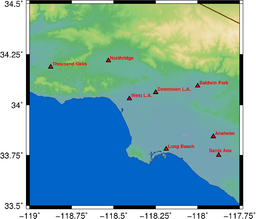Difference between revisions of "Virtual Shaker"
| Line 9: | Line 9: | ||
| − | + | ||
| + | |||
| + | == Software Design == | ||
| + | |||
| + | Convert Virtual Shaker Output to OBJ Files | ||
| + | |||
| + | Map Virtual Shaker Results to Damage | ||
| + | |||
| + | Render OBJ File | ||
| + | |||
| + | == Caltech Virtual Shaker == | ||
| + | |||
[https://virtualshaker.caltech.edu/index.php?todo=editview_strucdesgn&type=public&id=4 Building In Use] | [https://virtualshaker.caltech.edu/index.php?todo=editview_strucdesgn&type=public&id=4 Building In Use] | ||
Revision as of 23:07, 2 September 2010
CME team at SCEC can produce forward wave propagation data – ground motion time-histories (seismograms) for simulated earthquakes of various magnitudes. The largest, full dynamic earthquake simulation of magnitude 8 on southern San Andreas fault was led by SCEC last year. The seismograms produced by this simulation included frequency components up to 2 Hz. These seismograms can be applied to steel buildings models in virtual environment with Frame3D software, a building analysis program developed by Swaminathan Krishnan at California Institute of Technology. Frame3D allows us to perform efficient three-dimensional nonlinear analysis of steel buildings subject to ground acceleration records.
We needed a package to interface ground motion data with structural analysis software to visualize building response to ground motion time-histories. VShaker is set of tools developed at SCEC to provide this interface. It provides formatted ground motion time-history input to Frame3D software, process and visualizes its output data. The building analysis results from Frame3D are processed by VShaker program in two steps. The program first combines structural model, response data from Frame3D and ground motion data to build three-dimensional geometric representations of the structure at specified time intervals. These geometric representations are output as Wavefront OBJ files - a universal file format supported by major 3D rendering programs. In the next step VShaker can combine these snapshots to produce simple animations of structural motion with various viewpoints.
We are currently conducting a study to evaluate the response of two types of steel buildings with fundamental periods of 0.63 and 4.54 seconds subjected to acceleration records from SCEC M8 Simulation. These buildings are being simulated at eight locations spread out across Southern California. The locations were chosen based on a previous study conducted by Krishnan et al., on response of tall steel buildings for magnitude 7.9 1857 southern San Andreas Earthquake. The choice of building locations will allow us to compare the results of building response from our study to those reported in the earlier study. The tall steel building with fundamental period of 4.54 seconds had comparable responses to those reported in Mw 7.9 earthquake study.
VShaker has the potential to produce animations of structural motion after significant earthquake to aid in identification of damage to structural elements. It can also be used to effectively visualize performance of proposed building models to simulated earthquakes.
Software Design
Convert Virtual Shaker Output to OBJ Files
Map Virtual Shaker Results to Damage
Render OBJ File
